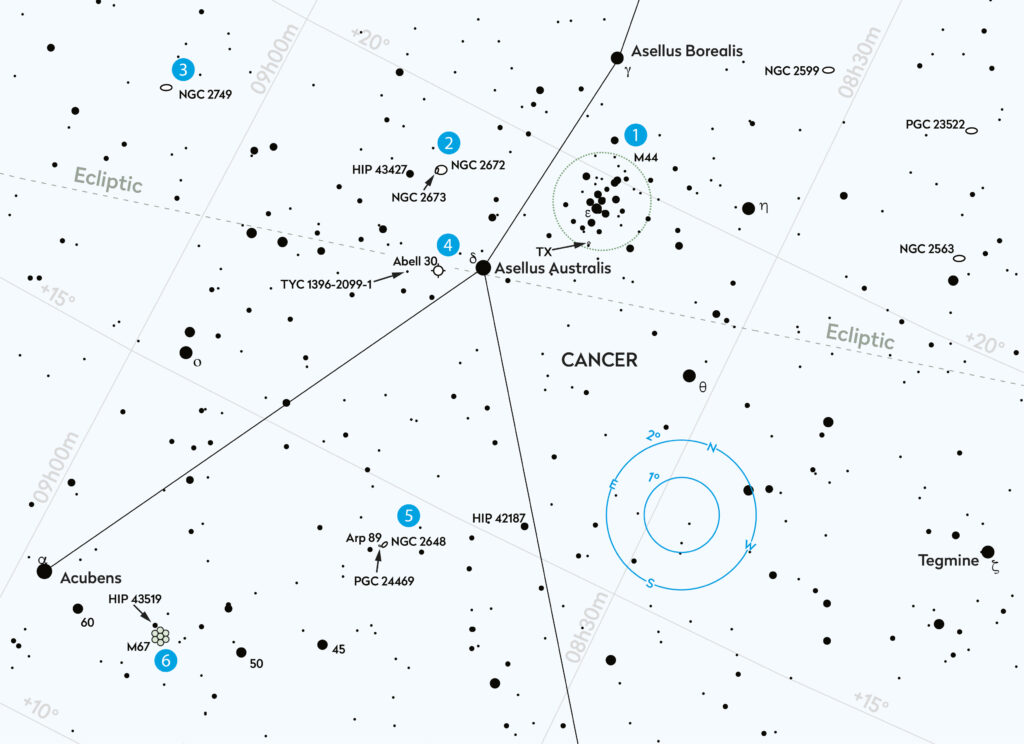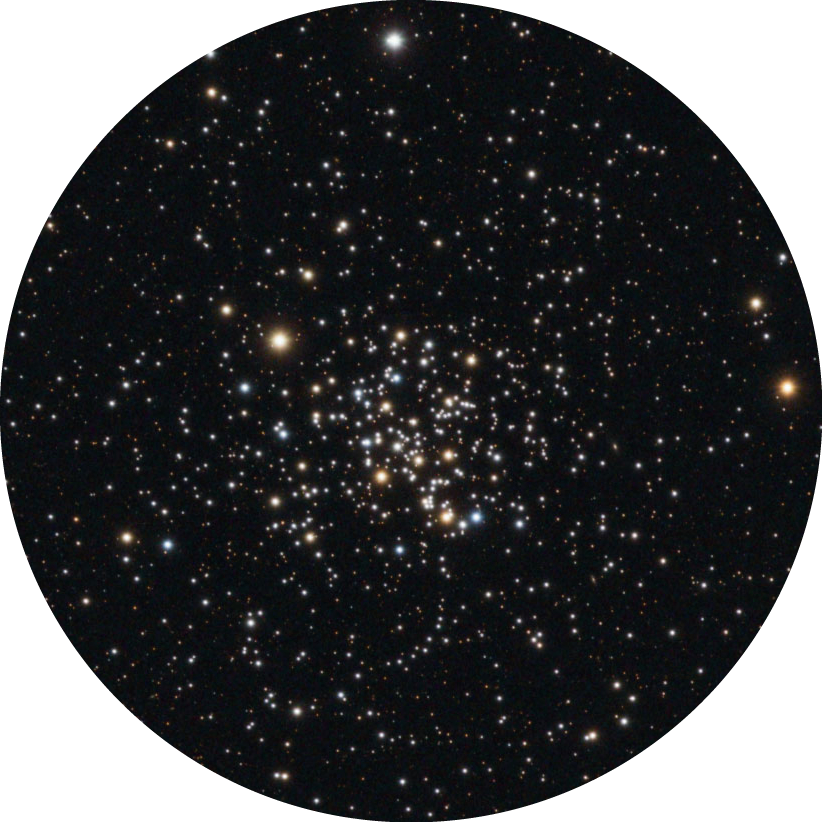Our tour includes peculiar galaxies and ancient clusters in the middle of Cancer

1. M44
Recommended equipment: Small/medium telescope
Our first target needs no introduction. M44, the Beehive Cluster, sits at the heart of Cancer, boxed in by Asellus Borealis (Gamma (γ) Cancri), Asellus Australis (Delta (δ) Cancri), Eta (η) and Theta (θ) Cancri. The cluster is rich, large and visible to the naked eye under dark skies. With an estimated distance of 594 lightyears, it’s one of the nearest open clusters, appearing 95 arcminutes across. It contains over 200 members, 20 brighter than mag. +8. M44 contains many multiple stars and in excess of 100 variables. Most appear towards the yellowred end of the spectrum, but one stand-out variable star, TX Cancri (mag. +7 to +8) appears blue.
2. NGC 2672
Recommended equipment: Small/medium or large telescope
Next is the elliptical galaxy NGC 2672. Wander to the southernmost edge of M44 (near TX Cancri) and look 1.9° to the east. The galaxy lies 0.4° northwest of mag. +6.4 HIP 43427. Discovered on 14 March 1784 by William Herschel, NGC 2672 is just about visible with a 150mm scope under dark skies, but relatively easy to see using a 250mm instrument. It appears circular around 40 arcminutes across, a glow with a tiny, almost stellar nucleus. There’s a challenge here for larger instruments: seemingly embedded within the east-southeast portion of NGC 2672’s outer halo is galaxy NGC 2673. In terms of brightness, NGC 2672 has an integrated magnitude of +11.6 and NGC 2673 is +12.9.
3. NGC 2749
Recommended equipment: Large telescope
Another elliptical galaxy, mag. +12.0 NGC 2749 is located 3.5° east of HIP 43427 mentioned above. It’s also 3.9° south and a fraction west of mag. +5.2 Xi (ξ) Cancri (not shown). This is a tricky object requiring aperture to see. A 250mm scope shows it as a glow about 1 arcminute in diameter. The glow appears mostly uniform, but rising to a sharp star-like nucleus. A 300mm scope shows a similar view except the nucleus appears displaced slightly towards the northeast. This is the brightest of a group of galaxies in this region best revealed using long-exposure photography.
4. Abell 30
Recommended equipment: Large telescope
The Abell Catalogue of Planetary Nebulae was compiled in 1966 by George Abell. It consists of 86 largely faint objects, most discovered on photographic survey plates taken with a 1.2m telescope at Mount Palomar. Shining at integrated mag. +13.0 and with a total apparent diameter of 2.1 arcminutes, Abell 30 is a very challenging object. It lies 0.6° east-southeast of Asellus Australis, roughly mid-way between this star and mag. +8.4 TYC 1396-2099-1. This is best-suited to a large, light-bucket instrument. A 450mm scope should do it, showing a 0.5-arcminute circular glow and dim mag. +14.3 central star. An OIII filter is helpful visually. If you don’t have a large scope, photography is the way to go.

5. NGC 2648
Recommended equipment: Small/medium or large telescope
NGC 2648 lies approximately two-thirds of the way from mag. +4.3 Acubens (Alpha (α) Cancri) and mag. +6.3 HIP 42187. It has an apparent magnitude of +11.8, but with a total apparent size of 3.2 x 1.1 arcminutes has low surface brightness. Only the bright core, about 50 arcseconds long, appears visually. The Palomar Sky Survey plates mentioned above were also used to identify many members of the Arp Atlas of Peculiar Galaxies, galaxies with unusual structures typically generated from active nuclei or gravitational distortions. Many are difficult targets for amateurs. Together with the adjacent mag. +14.6 galaxy PGC 24469, NGC 2648 forms Arp 89.
6. M67
Recommended equipment: Small/medium or large telescope
Overshadowed by its larger and brighter Messier neighbour, M67 is a sixth-magnitude open cluster 2° west of Acubens (Alpha (α) Cancri). With an apparent diameter around 30 arcminutes, through the eyepiece of a telescope M67 appears rich and condensed. A 150mm instrument reveals around 50 stars brighter than mag. +12 in an area 0.25° across. Around 100 members are visible in a 300mm scope at 120x power. The brightest star in the cluster appears to be HIP 43519 which shines at mag. +7.8, although this is a foreground object estimated to be one-quarter the 2,700-lightyear distance of M67.
MORE ONLINE
Print out this chart and take an automated Go-To tour
www.skyatnightmagazine.com/bonus-content/9BN84GZ